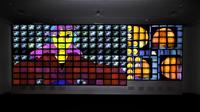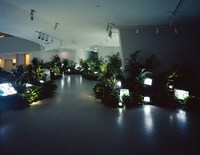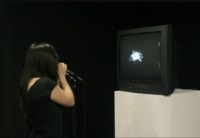Items
Tag
TV
-
 Megatron/Matrix Megatron Matrix is roughly the size of a billboard and holds 215 monitors. The video—augmented by a loop of unrelated soundbites—mixes images from the Seoul Olympics with Korean folk rituals and modern dance. Smaller clips play simultaneously on multiple monitors, while larger, animated images flow across the boundaries between screens, suggesting a world without borders in the electronic age. Paik sorted the monitors into two distinct sections. The Megatron conveys the vast reach of the media, while the smaller section, the Matrix, emphasizes the impact on each of us. In Matrix, Paik arranged the monitors so that the images seem to spiral inward around a lone screen showing two partially nude women. He may be suggesting that our bodies are our primal connection to the world, but the effect on the viewer is of being assaulted by "too much information." In the early 1960s, Paik began incorporating televisions into his collaborative performance pieces with American dancers, musicians, and artists. Today, the fusion of pop music, commercial culture, and nationalist symbols captures Paik's story and that of millions around the world. Paik's prophetic awareness of the power of television has been borne out in our "plugged-in" age, when any kind of art or entertainment is available on our screens all the time.
Megatron/Matrix Megatron Matrix is roughly the size of a billboard and holds 215 monitors. The video—augmented by a loop of unrelated soundbites—mixes images from the Seoul Olympics with Korean folk rituals and modern dance. Smaller clips play simultaneously on multiple monitors, while larger, animated images flow across the boundaries between screens, suggesting a world without borders in the electronic age. Paik sorted the monitors into two distinct sections. The Megatron conveys the vast reach of the media, while the smaller section, the Matrix, emphasizes the impact on each of us. In Matrix, Paik arranged the monitors so that the images seem to spiral inward around a lone screen showing two partially nude women. He may be suggesting that our bodies are our primal connection to the world, but the effect on the viewer is of being assaulted by "too much information." In the early 1960s, Paik began incorporating televisions into his collaborative performance pieces with American dancers, musicians, and artists. Today, the fusion of pop music, commercial culture, and nationalist symbols captures Paik's story and that of millions around the world. Paik's prophetic awareness of the power of television has been borne out in our "plugged-in" age, when any kind of art or entertainment is available on our screens all the time. -
 Technology
Technology
-
 TV Garden No artist had a greater influence in revealing the artistic potential lurking behind television’s flickering facade than Nam June Paik. Commonly hailed as the father of video art, Paik reshaped perceptions of the electronic image through a prodigious output of manipulated TV sets, live performances, global television broadcasts, single-channel videos, and video installations. His career took him from Asia through Europe to the United States, and Paik’s complex media-based art grew out of his early interests in electronics, as well as his foundations in performance and music. Arriving in New York in the mid-1960s, he joined a new generation of artists that was altering the ways in which one interacts with the moving image. Paik became a prominent member of the Fluxus movement, whose principles included the transformation of quotidian actions—like the buttoning and unbuttoning of a coat, as seen in his video Button Happening (ca. 1965)—into art. Quickly emerging at the forefront of this movement, Paik also sought to involve the viewer as an active participant in his performances and installations, and he often introduced elements of surprise and the unfamiliar. TV Garden, one of his seminal installations, illustrates Paik’s profound grasp of technology’s capacity for composition and the new aesthetic discourse that he helped to create. To enter the piece is to experience an uncanny fusion of the natural and the scientific, as hidden amid an undergrowth of live plants are video monitors of various sizes. All are playing the artist’s 1973 collaboration with John J. Godfrey, Global Groove, which montages performers from around the world into a gyrating visual mix, and the videotape’s sound track serves as musical and spoken counterpoint to the monitors’ flickers of light. TV Garden set a new standard for immersive, site-specific video installations. Restaged for the artist’s exhibition at the Guggenheim Museum in 2000, its influence can be seen decades later in ambient, room-sized installations by such artists as Gary Hill and Bill Viola. For Paik, the artist should not be limited in seeking new forms of creative expression, but rather the potential for innovation must be continually reimagined. Just as Paik reconceived broadcast television in the 1960s and 1970s in order to “turn it inside out” and deliver a fresh take on this means of communication, Paik turned to laser technology as a novel type of sculptural and installation art at the beginning of the 21st century. He continued to dismantle customary ways of seeing and expand the parameters of art making throughout his career.
TV Garden No artist had a greater influence in revealing the artistic potential lurking behind television’s flickering facade than Nam June Paik. Commonly hailed as the father of video art, Paik reshaped perceptions of the electronic image through a prodigious output of manipulated TV sets, live performances, global television broadcasts, single-channel videos, and video installations. His career took him from Asia through Europe to the United States, and Paik’s complex media-based art grew out of his early interests in electronics, as well as his foundations in performance and music. Arriving in New York in the mid-1960s, he joined a new generation of artists that was altering the ways in which one interacts with the moving image. Paik became a prominent member of the Fluxus movement, whose principles included the transformation of quotidian actions—like the buttoning and unbuttoning of a coat, as seen in his video Button Happening (ca. 1965)—into art. Quickly emerging at the forefront of this movement, Paik also sought to involve the viewer as an active participant in his performances and installations, and he often introduced elements of surprise and the unfamiliar. TV Garden, one of his seminal installations, illustrates Paik’s profound grasp of technology’s capacity for composition and the new aesthetic discourse that he helped to create. To enter the piece is to experience an uncanny fusion of the natural and the scientific, as hidden amid an undergrowth of live plants are video monitors of various sizes. All are playing the artist’s 1973 collaboration with John J. Godfrey, Global Groove, which montages performers from around the world into a gyrating visual mix, and the videotape’s sound track serves as musical and spoken counterpoint to the monitors’ flickers of light. TV Garden set a new standard for immersive, site-specific video installations. Restaged for the artist’s exhibition at the Guggenheim Museum in 2000, its influence can be seen decades later in ambient, room-sized installations by such artists as Gary Hill and Bill Viola. For Paik, the artist should not be limited in seeking new forms of creative expression, but rather the potential for innovation must be continually reimagined. Just as Paik reconceived broadcast television in the 1960s and 1970s in order to “turn it inside out” and deliver a fresh take on this means of communication, Paik turned to laser technology as a novel type of sculptural and installation art at the beginning of the 21st century. He continued to dismantle customary ways of seeing and expand the parameters of art making throughout his career. -
 Buddha Watching TV "“The real issue implied in “Art and Technology” is not to make another scientific toy, but how to humanize the technology and the electronic medium, which is progressing rapidly—too rapidly.” —Nam June Paik Paik, undoubtedly the single most important figure in the history of video art, established the medium in the early 1960s. Buddha Watching TV comes from one of his most celebrated video sculpture series. Paik created the original concept in 1974 and made this example in 1997. Here a stone Buddha head from Indonesia, partially embedded in dirt and signed dramatically across the back by Paik in Chinese and English, appears to observe itself on television. A live image of the unchanging head is continuously relayed to the monitor by the closed-circuit camera on the tripod. The Buddha thus generates and receives its own image in an infinite temporal loop, updating the act of contemplation for the age of technology."
Buddha Watching TV "“The real issue implied in “Art and Technology” is not to make another scientific toy, but how to humanize the technology and the electronic medium, which is progressing rapidly—too rapidly.” —Nam June Paik Paik, undoubtedly the single most important figure in the history of video art, established the medium in the early 1960s. Buddha Watching TV comes from one of his most celebrated video sculpture series. Paik created the original concept in 1974 and made this example in 1997. Here a stone Buddha head from Indonesia, partially embedded in dirt and signed dramatically across the back by Paik in Chinese and English, appears to observe itself on television. A live image of the unchanging head is continuously relayed to the monitor by the closed-circuit camera on the tripod. The Buddha thus generates and receives its own image in an infinite temporal loop, updating the act of contemplation for the age of technology." -
 Participation TV This work is one of the 13 experimental televisions shown in Paik’s first solo exhibition in Wuppertal, Exposition of Music—Electronic Television (Germany, 1963). Its earlier form was sheer acoustic, while the later version of Participation TV visualized amplification of sound. When someone speaks or makes a sound into the microphone, the monitor shows several images. The work housed by the Nam June Paik Art Center was re-made in 1998. When someone makes a sound into the microphone, the acoustic signals are transformed into fine electronic signals, which are amplified and displayed as visual patterns. According to the rise and fall and volume of the sounds made by the audience, the lines split into three colors (red, green, and blue) are transformed into images that are not able to be predictable nor repeat themselves.
Participation TV This work is one of the 13 experimental televisions shown in Paik’s first solo exhibition in Wuppertal, Exposition of Music—Electronic Television (Germany, 1963). Its earlier form was sheer acoustic, while the later version of Participation TV visualized amplification of sound. When someone speaks or makes a sound into the microphone, the monitor shows several images. The work housed by the Nam June Paik Art Center was re-made in 1998. When someone makes a sound into the microphone, the acoustic signals are transformed into fine electronic signals, which are amplified and displayed as visual patterns. According to the rise and fall and volume of the sounds made by the audience, the lines split into three colors (red, green, and blue) are transformed into images that are not able to be predictable nor repeat themselves.